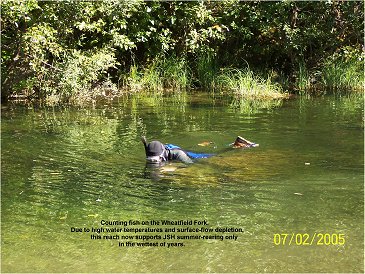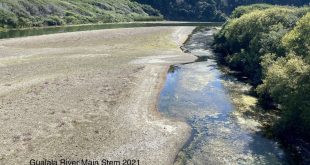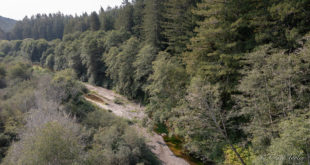A fish and wildlife biologist, retired from the U.S. Fish and Wildlife Service, has been conducting systematic studies of the population status of steelhead in the Gualala River since 2001.
Annual spawning surveys focus on an 18 mile reach of the Wheatfield Fork selected as a population-indexing reach.
Gualala River Steelhead Studies
Over the years, he has compiled a wealth of detailed information about steelhead in the Gualala River, which he recently summarized in:
Ten Years: Ten Revelations
by Richard W. DeHaven
“For visitors with limited time or cursory interest in the subject, here is the big picture (in ascending order of importance):
- Restoration efforts on the river to date have failed to increase SH populations.
- Short-term studies of SH on the river fall short in pursuit of truth.
- Most life history aspects of the river’s SH are keyed to “going with the flow (of the stream).”
- Visual counts of adult SH from a small boat, can provide inexpensive population monitoring on this stream under certain conditions.
- The average annual return of adult SH back to the river today appears to be at least a few thousand fish.
- The river’s estuary provides an important “hedge” for juvenile SH rearing, when drought, excessive temperatures and other adverse stream conditions impact rearing in upstream reaches.
- Quality of summertime rearing conditions for juvenile SH in upstream areas is a main determinant of subsequent (2-3 years later) adult SH spawning returns.
- Timber harvesting in the watershed today poses a less severe threat to the river’s ecosystem and SH than previously.
- Today, grape vineyards pose one of the most serious threats to the river’s SH and ecosystem.
- Preserving any sizeable SH population in the river into future decades will require preserving and protecting summertime stream flows from reductions caused by a myriad of developmental activities, including grape vineyards.
Read the complete article,
Ten Years: Ten Revelations
along with annual reports & much more,
on his website: Gualala River Steelhead Studies
 Friends of Gualala River Protecting the Gualala River watershed and the species living within it
Friends of Gualala River Protecting the Gualala River watershed and the species living within it



